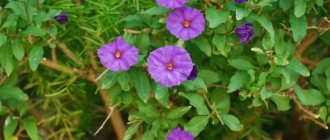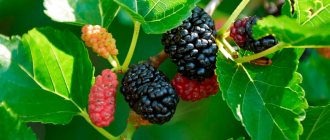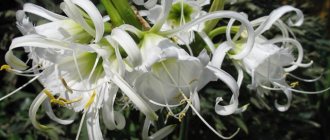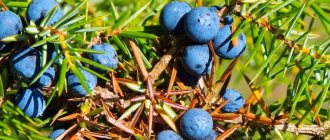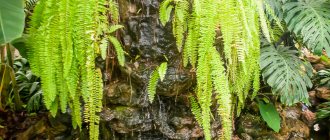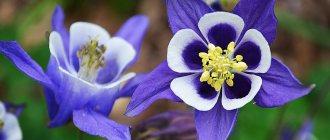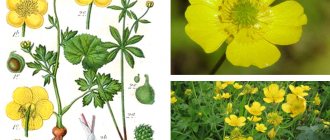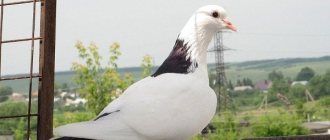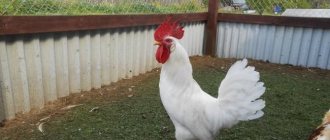Proper maintenance of turkey ducks in winter
At home, ducks should only be kept in a spacious barn, as these birds do not like cramped spaces.
Expect to need an average of 2 meters per 3 individuals. If you breed turkey ducks only seasonally, you can keep them together with other types of birds. The Indian duck behaves calmly towards other birds and does not defend its territory. When kept in the cold season, the poultry house must be equipped according to all standards. In winter, it is very important that there are no sudden changes in temperature, dampness and musty air in the barn. It is for these reasons that Indian ducks most often get sick.
Breeding and further care includes daily washing of drinkers and feeders. General cleaning should be carried out once a week using disinfectants. If you follow all aspects of care and treat parasites in the room where turkey ducks are kept, then the birds will fully grow and develop. For more details on how to raise and keep turkey ducks in winter, see the photo or video. At home, for the winter, and better yet for other times of the year too, the nests should be filled with warm materials, such as sawdust or straw. Several females can lay eggs in one nest at once.
Living conditions and care
The Muscovy duck is a heat-loving bird that cannot tolerate frost. For the livestock, an insulated barn is built with the possibility of additional heating (IR lamps, stoves) in case of winter frosts. The temperature in the barn should not be allowed to drop below 0 degrees, and the temperature comfortable for the livestock is +15...+20 degrees.
To bathe, mute birds do not need to install baths or dig a pond; it is enough to place a basin or bucket of water so that the bird can rinse its beak. In winter, in order to avoid dampness in the barn, a bucket of water is placed on a wide basin covered with a net. All the water splashed out of the bucket by the ducks will end up in the basin, and the net will prevent the birds from dragging it around the barn.
In the duck house, in addition to feeders and drinkers, nests in the form of houses are installed. Their number should correspond to the number of females on the farm. Muscovy ducks cannot stand competitors sitting nearby on eggs and start fights.
Grain, vegetables and hay are prepared for the winter as food for the mute ducks. In summer, ducks are released to graze, where they readily eat succulent vegetation.
Families are formed from 1 drake and 3–5 females. Ducks incubate eggs for 33–35 days, the percentage of chicks hatching under the hen is very high. If you take the babies and raise them yourself, the duck will rest a little and then hatch again and hatch more ducklings before the cold weather sets in.
Existing types of indo-ducks
It should be noted that the types of musk ducks differ not only in the color of their plumage, but also in the color of their eyes, legs and beak.
Particularly popular are Indian ducks that have the following characteristics:
The white Indian duck has a snow-white color, blue-gray eyes and yellow legs. The beak is light pink in color, paler at the end.
The black color of the bird's feathers gives off a violet tint throughout the body, but dark green patches predominate in the area of the back and wings. Her eyes have a light brown tint. The metatarsals are dark in color, and the beak is often red, but in some cases black. The black and white duck has black plumage with a purple tint on the body and a well-defined green on the back. As a decoration, the head is covered with white feathers, which gradually move to the chest and partially dilute the black plumage on the wings.
They have brown eyes, yellow legs and a red beak with a darkened tip.
The brown and white Indian Duck attracts attention with its brown color with a chocolate-green tint. Their head and chest are decorated with white feathers
On the wings the darker color of the feathers predominates, closer to chocolate, this is especially well expressed on the flight feathers. The eyes, like the metatarsals, are brown in color. The red beak is characterized by a dark spot at the tip. The brown (red) bird is interesting for its dark chocolate color with green and black tints on the tip of the tail and the flight feathers of the wings. Red Muscovy ducks have dark brown eyes. The brown duck's short, strong feet have good stability, which helps in its movement. The reddish beak is characterized by darkening at the tip. Red Indian ducks are very popular due to their attractive color.
The patterned white duck is characterized by black spots on the surface of different parts of the body on a main white background: on the crown, back, sides, tail, lower leg, and inner integumentary feathers of the wings. It has light brown eyes and yellow metatarsals, sometimes with black spots. The red-bluish beak has a black spot at the end. The blue duck has gray plumage with a bluish tint with darker edging on the wings. There are black spots on the dark gray beak. The eyes may have a gray-blue or light brown color, and the metatarsals are gray.
Meat focus
Meat poultry is in greatest demand among farmers. Popular varieties of such ducks:
| Photo and name of the duck | Description | Productivity |
| Beijing | It was developed in Beijing about 300 years ago. Large breed for meat production. Drakes are larger than females, both have stocky bodies, with a wide chest and a straight back. Medium-sized head with a powerful beak and large eyes. The neck is strong and long. The limbs are small, strong, and widely spaced. Frost-resistant, has a subcutaneous fat layer | Meat when released is about 4 kg. Female egg production - up to 90 eggs per year |
| Gray Ukrainian | It was bred by selection in Ukraine. Representatives of the breed have original colors. The color is dominated by gray, emerald, black and white shades. The skeleton is strong, but light. The muscles are well developed, the back is long and wide. The chest is deep, slightly rounded. The wings are powerful, pressed to the body. Males are larger than females, and the color of their feathers is more varied. The drake's head is emerald, and there is a white ring on its neck. The chest is dark chocolate, the belly is white. The tail and the end of the back are black. Females are cream-colored, the feathers have brown spots and blue feather “inserts” | Meat yield at slaughter is 3.5 kg. A duck can lay about 80–90 eggs per year |
| Black white breasted | The subspecies is considered meat. The Black White-breasted Duck is a large bird with predominantly black, white and malachite (in males) colors in its plumage. The head is small, elongated, the beak is short, dark in color. The body is vertical, slightly elongated, with a rounded chest and thin neck. The limbs are short but strong. The bird's color is black, except for the chest. She and upper belly are white | Meat yield at slaughter is 3.5 kg. One individual produces up to 100 eggs per year |
| Indoutka (musk) | Ducks with red beaks. The color is dominated by white, black, brown and gray shades. A bird with a powerful body and well-developed muscles. The sternum is rounded, wide, the back is flat and straight. The wings are powerful, well developed, tightly pressed to the body. The limbs are strong, short, and widely spaced. The average weight of a drake is about 6 kg, females - up to 4 kg | The meat yield at slaughter is about 5-6 kg. A female individual lays about 120 eggs annually |
| Crested | They were developed in Europe in the 18th century. Duck with a long beak. The head is crowned with an original feather crest. The bird has a decorative appearance. The body is of medium length, strong build. The back is wide, the chest is convex. The neck is long, the head is medium size. The color is dominated by white, cream, and gray shades. The plumage is dense. The wings are powerful, tightly pressed to the body | High meat yield - 5–6 kg. Egg production - 110 eggs per year |
| Swedish blue | Representatives of this breed are large, with a dense build. The head is oval, the beak is flat, flattened. The back is wide and straight. The tail is short. The plumage is dominated by white, black and gray shades. Chest is round | Meat yield - 4 kg. Egg production - 120 eggs per year |
| Mulard | It was developed in 1960 in France. Large breed, with a small head. The beak is light, slightly elongated. The neck is long, the chest is convex and wide. The back is straight and level. The color is predominantly white and black. The legs are strong, short, yellow in color. There are black spots at the base of the beak | Meat yield at slaughter - 4 kg, egg production - up to 120 eggs |
| Blue favorite | A new breed, was bred in 1998. It is popularly called the pharaoh and the blue duck. A large bird with a massive beak, a small head and a short neck. The chest is deep, the back is wide and straight. The tail is short, the wings are pressed tightly to the body. The color is dominated by blue and ash-gray colors. Paws are strong, yellow, widely spaced | Egg production - up to 120 eggs per year, meat yield at slaughter - about 4-5 kg |
| Moscow white | It was bred through selective breeding. A bird with a dense build and thick white plumage. The body is massive, the chest is round and wide. The head is medium in size, with a bright red beak. The neck is of medium length, flexible. The back is straight, wide, ending in a small neat tail. A distinctive feature is the color of the iris of the eyes. She is blue | The yield of meat at slaughter is 4.5 kg. Egg production is average, about 90 eggs per year |
Female meat duck breeds are capable of laying eggs. The performance and quality of the products are average. The disadvantage of egg-laying breeds is that the duck gains maximum weight in 8–12 months. Then its content becomes meaningless.
Mulard
If we are talking about meat breeds of ducks, then it is worth remembering the mulards. To obtain this breed, breeders for many years tried to cross two breeds - the oriental, which we talked about at the very beginning, and the musk, which was discussed before. The result was really surprising, because already at 2 months these ducks can weigh almost 3.5 kg, which is one kilogram more than Peking ducks.
If you are not yet sure that this is a significant discovery and an important breed, you should know that in France there are almost always about 35 million representatives of this species. This is because the liver of females of this breed is used to prepare a famous and expensive delicacy - foie gras.
Advantages of mullards
Breeders, crossing Muscovy and Pekin ducks, have achieved excellent results. Ducks born after such crossing are called mullards. They are infertile and cannot have offspring, but at the same time they have undeniable advantages:
- Early ripening;
- Hardy;
- They are characterized by high productivity (meat, eggs);
- The unusually tender liver of mullards is used to prepare the most delicious and expensive dish, foie gras.
Against the background of such a list, the fact of infertility does not seem to be a big disadvantage or obstacle to breeding these birds.
Breed varieties
Indo-ducks were selected not so much for product characteristics as for color. To increase production yield, a hybrid was created. Today there are the following varieties:
- White. Plumage Completely white, gray eyes, yellow paws.
- Black. Plumage Completely black, green on the back, purple on the sides, black or spotted beak, black-brown eyes, gray down.
- Black and white. The plumage on the back and sides is black with greenish and purple tints, respectively. White feathers appear in the form of spots on the head and chest. The eyes are brown, the beak is red, the legs are yellow with dark specks.
- White-brown. The feathers on the back, tail and sides are chocolate with a green tint. The head and chest are white, the beak is red with a dark base, and the legs are dark.
- White with a pattern. The plumage is white; there are black spots of irregular shape on different parts of the body. The beak is red-blue, the tip is black, the eyes are brown.
- Blue. The plumage is gray-blue, with dark edging on the flight feathers. The eyes are brown, the beak is gray-black. The bird looks elegant and is recommended to be kept as a decorative bird.
- Brown. These are chocolate-colored wild ducks. The bases of the feathers are white. The beak is red-brown, the eyes are brown. Indo ducks are beautiful, but weigh less than other breeds.
Now they are starting to crossbreed ducks of different colors, creating new breeds. Interspecific crossing is also practiced to develop crosses and hybrids. If you want to have a truly productive livestock, it is better to buy young stock from trusted companies.
Description of the breed
Indo-ducks are called musky ducks for emitting a specific odor. Raising poultry of this breed does not require specific knowledge and skills. Even novice poultry farmers cope with the task. But consulting with experienced people won't hurt.
To understand what Indian ducks are and how to properly care for them, you need to familiarize yourself with the description and characteristic features of these pets.
Appearance and character
The external characteristics of musk ducks differ from ordinary poultry. In addition to the beautiful color of their plumage, turkey ducks have an expressive growth on their beak, just like turkeys. Hence the name.
These birds are large in size, with a strong constitution:
- The Muscovy duck has a wide chest;
- short but strong legs;
- carcass shape - squat, elongated;
- powerful wings with dense plumage;
- the neck is thick and short.
An adult musk drake weighs up to 6 kilograms, the female weighs about 3.5 kilograms.
There are practically no more calm and quiet domestic birds. But they can conflict with other breeds and start internecine fights.
Health and performance indicators
Muscovy ducks, unlike other waterfowl, can live far from bodies of water and feel comfortable. These poultry have good health and excellent immunity. Even without vaccinations they don’t get sick. The problem arises if you keep birds in a cold coop in winter.
You also need to remember that musky representatives of the duck tribe do not have feathers or fat on their legs. Dampness and low temperatures cause frostbite.
The musky breed of poultry is raised for its tasty meat, which does not have the specific smell inherent in wild birds. Meat is considered a dietary product because it has virtually no fat.
Duck eggs are no less valuable. They are not only tasty, but also healthy.
Advantages and disadvantages of Indoutka
Breeding indo-ducks does not require special knowledge and skills, but it has its pros and cons. The advantages include the following factors:
- resistance to various diseases, which has a greater impact on the survival of young offspring;
- unpretentiousness to feeding;
- high egg production;
- feel great in any environment;
- Indian ducks are good brood hens, even for hatching other bird species;
- delicious dietary meat.
As for the disadvantages, there are much fewer of them than advantages:
- small ducklings can peck at each other if the necessary conditions are not provided;
- addiction to shiny objects;
- slow growth and weight gain.
About the maintenance and breeding of the Muscovy Duck, watch the video below:
Breeding Muscovy ducks at home
Indo-ducks are much easier to breed than any other poultry.
- The broodstock should be formed one and a half months before the start of egg laying. This is usually done from May to July.
- If the drake is a month older than the laying hens, the latter will reach sexual maturity a little earlier.
- For good egg laying, artificial lighting for six-month-old ducks increases daylight hours. By the time egg laying begins, it should reach seventeen hours. One and a half months before the end of egg laying, it should be extended for another two hours.
- Muscovy ducks eagerly sit on eggs, and after the chicks hatch, they take excellent care of their offspring.
- By autumn, the family will be provided with delicious poultry meat.
- In order for ducklings to appear again in the spring, you can take several ducks and one drake in the winter. Many poultry farmers adhere to this scheme for breeding Muscat ducks.
Indian ducks cannot withstand dampness and dirt. The best temperature for oviposition is nineteen degrees.
Indo-duck nests
You should prepare the nest for the laying hen in advance:
- You can use a cardboard box as a nest and put non-synthetic fabric on its bottom. For example, burlap.
- The Muscovy duck sits on the nest after laying about two dozen eggs. She won't sit on an empty nest. Therefore, you need to save them within two to three weeks.
- Since the bird will remain in the nest for a considerable number of days, it is necessary to place a drinking bowl and a container of water next to it in which it can bathe. After bathing, the nest is moistened and a large number of parasites are destroyed.
- After two days of the Indian duck being on the eggs, another twenty eggs can be placed in her nest.
- Other people's ducklings should not be allowed near the hen. She can go for a walk, leaving the nest with eggs behind.
The first egg production cycle lasts about five months. Then a three-month break begins, during which the Indian ducks molt.
Growing and keeping Muscat ducklings
Ducklings are hatched on the thirty-third to thirty-fifth day:
- Ducklings weighing fifty to seventy grams are considered well developed. They have shiny, bulging eyes, yellow shiny fluff, and stand firmly on their feet.
- Day-old ducklings do not yet know how to drink and eat, so they need to be taught.
- On the first day they should be fed only boiled eggs. On the second day, porridge and milk are added.
- If the duckling will not eat, then it must be force-fed.
- After five days, the chicks can begin to be fed with finely chopped homemade meat waste with the addition of the mineral supplement “Solnyshko”, which boosts the immune system and stimulates growth and development.
- On the tenth day after birth, potatoes can be introduced into the ducklings' diet.
When trying to breed chicks artificially using an incubator, low hatchability was noted. Incubating eggs with hens is the most effective way to raise ducklings.
Interesting Facts
Mute birds not only fly well, but also climb vertical surfaces well with the help of sharp claws. To prevent the grown-up young from traveling, the flight feathers on one wing are trimmed. It is better to make a fence in a duckling's enclosure not from a mesh, but from a picket fence or solid pieces of slate or iron.
If you combine two ducks with broods in one room, the stronger female can take the children from the weaker duck and raise them herself.
Sitting on the nest and raising the young, the duck shows courage and selflessly protects the offspring. There are known cases when musk hens killed large rats with their beaks that wanted to steal eggs.
A day old duckling should see its first food in motion. In nature, ducklings immediately begin to hunt for insects after hatching. At home, food is poured on top of the backs of the chicks. The food rolls off the back onto the floor, the ducklings see the movement and grab the pieces. Having tasted the food, they already begin to eat from the bowls.
Muscovy duck is popular and in demand in small and large farms. Due to the unpretentiousness of Indian ducks in keeping and feeding, breeding this bird is economically profitable. An incubator is not required to produce ducklings, as female musk ducks are excellent brood hens and mothers.
Obtaining offspring and breeding
Natural reproduction is easy. Only fertilized material is used for breeding. It is best to isolate families shortly before the start of the breeding season. Then nothing will distract the drake from the main task.
To increase the chances of high-quality offspring, the head of the family is fed sprouted grain. You can install a separate feeder for it. A good addition to the diet is grass flour, dried shoots from trees, nettles, harvested in the summer.
During the breeding season, the deficiency of iron, iodine and manganese in the body should be compensated. A lack of them will result in very thin egg shells. Green feed, cereals and legumes (soybeans, crushed peas), and animal products are needed. A useful additive is soybean cake and fish meal - they contain sulfur.
Mute cats are very good mothers. They take their responsibilities very seriously. An Indian duck is ready to become a mother 6-7 months after birth. Around February-March, mallards begin to lay eggs. The owners should collect them and date them. Store in a cool place, with the pointed end down. It is advisable not to leave eggs for longer than 2 weeks (for other breeds these periods are much shorter).
A mallard that is ready to hatch ducklings behaves in a special way. She does not want to leave the nest, she insulates it by putting fluff there, which she pulls out of her chest. You need to put a dummy in the nest; if the bird sits on it, you can add real eggs. After a couple of days, you can add eggs from other ducks - up to 20 in total.
A feeder and drinking bowl are placed next to the nest so that the mother does not leave the nest for a long time. The amount of feed is not limited. The nest is located in a secluded place; it is better to separate it using partitions. A nervous situation can force an Indian duck to leave the clutch.
Premises requirements
If Indian ducks are bred as producers of eggs and ducklings, a poultry house should be prepared for their residence.
If the bird is raised for meat, you can keep it in an aviary; in case of rain, it is advisable to provide a covered area.
The requirements for the “house” are not simple enough:
- height up to 2 meters;
- the area depends on the number of “tenants” (approximately 1 square meter for 4 individuals);
- windows at a height of 0.8-1 m, and the area of window openings should be at least 10% of the floor area;
- It is advisable not to paint the walls, but to whitewash them, and cover the floor with straw or sawdust, which can be easily replaced;
- the feeder is placed in such a way that all the ducks can eat at the same time and not injure each other;
- It is better to choose stable, trough-shaped drinkers so that the birds cannot splash the water;
- artificial lighting is carried out at the rate of 5 W per 1 sq. m.
Important! The temperature in the poultry house should not drop to below zero. During the period of hatching chicks, it is necessary to create warmer temperature conditions - up to +20 degrees.
Muscovy duck - origin and description
Muscovy ducks, also known as Indo-ducks, are a distinct species of Anatidae birds native to Central and South America.
The origin of the term “muscovy” duck is quite controversial and vague. According to some sources, the name comes from the ability of old birds to secrete musky fat from growths on their heads. However, ducks do not actually produce any musk. According to another version, the term is a highly distorted word "Muscovia". The fact is that poultry was imported to Europe by the Moscow Company, an English enterprise that, among other things, had a monopoly on trade between the Muscovite kingdom and the Kingdom of England.
But in the countries of the former Soviet Union, the bird is known as the “indo-duck”. The name appears to be short for "Indian duck."
It is not known exactly when wild musk ducks were domesticated. However, by the time Europeans arrived in the New World, local Indians had been breeding these birds for many centuries. In the 16th century, ducks came to Europe and Africa, and later to Asia and Australia. Birds were brought to Russia quite recently - in the 1980s.
Despite certain similarities, the Indian duck is not a direct relative of the ordinary domestic duck, which has been bred since ancient times in the Old World.
Plumage comes in several varieties:
- black,
- white,
- black with white wings,
- fawn, etc.
Fleshy red growths are located around the eyes and above the beak, which are one of the most characteristic features of this species. An adult male musk duck grows up to 90 cm in length, females are noticeably smaller - 60-70 cm. The weight of a drake ranges from 4-6 kg, females - 2-3 kg. At the same time, in comparison with ordinary domestic ducks, Indo ducks grow much slower.
The diet is based on herbaceous plants and insects. The female is capable of laying an average of 80-110 eggs per year. In addition, ducks of this species are excellent hens; they will willingly incubate the eggs of other poultry if they are placed in the clutch.
Unlike ordinary ducks, indo-ducks do not quack, but hiss, that is, they make MUCH less noise, which is important for large-scale poultry farms. These birds are also famous for their dietary and very tasty meat, which is superior in its characteristics to the meat of ordinary ducks. Despite the distance of relationship, Indian ducks can interbreed with domestic ducks
This is how early ripening hybrids are obtained - mulards, which on average weigh about 4 kg
Despite the distance of relationship, Indian ducks can interbreed with domestic ducks. This is how early ripening hybrids are obtained - mulards, which on average weigh about 4 kg.
By the way, it is musk and mulard ducks that are used to produce special foie gras liver.
Pros and cons of “musks”
Many European and domestic poultry farmers involved in breeding “indo-ducks” prefer this bird to ducks of other breeds for the following reasons:
- The birds are large, their carcasses contain a large amount of muscle tissue.
- The meat is not very fatty, tender, tasty. It is devoid of a specific “duck” taste and is ideal for preparing many “haute cuisine” dishes.
- Eggs have good taste and qualities that allow them to be used in baked goods.
- Ducks are unpretentious in food and resistant to diseases.
- They have a calm character and behave much quieter than other ducks.
- Females are wonderful hens and wonderful mothers.
- Young animals have high immunity and demonstrate excellent survival rates.
- Caring for a bird is simple, even a beginner can handle it.
- “Musks” are easily crossed with most breeds of domestic ducks, which makes it possible to obtain broiler “mulards” in personal backyards, which are excellent fatteners.
In winter, birds are released for short-term walking in the absence of severe frosts.
Against the background of such a set of positive qualities, the “cons” of representatives of this species are considered insignificant. We can name, perhaps, only not very high resistance to frost and the risk of damage to the paws in cold winters. This problem can be easily minimized by housing the ducks in a room protected from dampness and drafts and equipped with dry floors with thick, hygroscopic bedding. In such conditions, “musks” successfully winter even in regions with a harsh climate. Unfortunately, most large breeding farms do not breed purebred “indo-ducks”. However, future owners do not experience any particular difficulties in acquiring “starter” individuals. Hatching eggs and day-old young of these birds are widely available for sale: they are offered by both farmers and many amateur breeders.
The bird is very popular among owners of private farms and households
Profitability of breeding musk ducks
Before building a duck house and buying young birds, it is worth analyzing the financial side of the issue in detail. We confidently declare that it is possible to make money on Indian ducks, but for this you need to properly calculate everything and make sure that it will be profitable in your conditions. After all, it’s one thing to convert a shed next to a house in the suburbs, and quite another to buy land and build everything from scratch.
For those who already have experience in entrepreneurship, drawing up a business plan will not be a problem. If you are trying your hand at business for the first time, it would be better to turn to professionals who will prepare a realistic business plan for a small amount. However, for those who live in the village, have enough free land, several free sheds and a small start-up capital, there is an opportunity to test the prospects of raising musk ducks on a trial batch of indo-ducks, say on several dozen heads.
Peking ducks: photo, breed description, characteristics
Peking ducks are easily recognizable at the breeder's yard, as their body is covered with white feathers, less often with a creamy tint. The plumage is thick and dense, the wings are powerful, with a large span, the large head is set on a long neck. Peking ducks are deservedly considered a broiler breed because they have well-developed muscle tissue and grow very quickly.
According to poultry farmers, an adult female at the age of 40-50 days weighs at least 3 kg, which is quite enough to sell products on the market. Males at 1.5 months weigh about 3.5 - 4 kg. During the egg-laying period, a duck lays about 90-100 large eggs. With intensive feeding and good housing conditions, it is possible to get 120-130 eggs from one duck.
Many poultry farmers send ducks for slaughter when they are 1.5 months old. The reason for this decision is that it is during this period that the bird carcass does not yet have time to accumulate a lot of fat. The meat of young birds is juicy and tender, which arouses great interest among market housewives and connoisseurs of dietary delicacies.
Leaving a duck to grow for more than 2 months should not send waterfowl to slaughter. At the age of 2 months and older, Pekin ducks begin a molting period and develop coarser plumage. If you pluck a duck during molting, its carcass will look unattractive and lose its presentation. Summer molting begins in May - July and lasts about 10-14 days. Autumn occurs over a longer period.
If you leave the bird to grow further, the meat will become fatty and high in calories. Some people deliberately keep ducks longer than usual to obtain more liver, which is used to make foie gras. This delicacy is highly valued in the market.
To raise ducks to obtain a large amount of fatty liver, it is necessary to create a waterfowl diet. Peking ducks are intensively fed with grain and grain mixtures, high-calorie feed prepared independently. Ducks are often force-fed using special devices.
Peking ducks are deservedly considered a broiler breed because they have well-developed muscle tissue and grow very quickly.
Poultry house equipment
The poultry house is equipped with the necessary equipment for the comfort of the indo-ducks:
Feeding the unpretentious musk duck is done differently for early ducklings and mature ducklings. For the first three days, the chicks are given a finely chopped duck or chicken egg. Next, various crumbly mash with broth or milk, cottage cheese, and herbs are gradually introduced.
Jerusalem artichoke promotes rapid weight gain
At the age of two weeks, root vegetables, dry or boiled (necessarily crumbly) grain are added to the feeders. Sand and gravel are poured into separate boxes.
Weight gains quickly when fed with Jerusalem artichoke. Ducks love its green shoots and tubers. It adds shine to the plumage and increases egg production.
Hay, dried branches, and vegetables are used for feeding during the winter months. Forb silage, chopped, lightly salted, is placed tightly in glass jars, and 1 aspirin tablet is added on top. The mixture is well preserved in the cellar.
To speed up fattening, boiled corn flavored with fat is added to the diet. Give the bird unsteamed feed. The dry mixture is rich in vitamins and nutrients.
Indian ducks drink large quantities of water. This is a distinctive feature of birds. They must satisfy their needs freely from birth. Ducklings completely immerse their beaks in the water. Drinking bowls are installed taking into account convenient access.
The nest for the Muscovy duck is placed above the floor. The best option is a house with a hole. Keep it dry by replacing contaminated straw.
An important point is the density of heads during cultivation. One m² should accommodate no more than 20 individuals for the first 14-20 days. When the babies reach the age of 21 days, the area is calculated at the rate of 6 males per 1 sq.m. Females, with a more miniature physique, are arranged in groups of 8 heads. When kept on a mesh floor, the number of ducks can be increased to 12.
Young Indian ducks can be kept at a rate of 6-8 birds per square meter. m.
A month before the start of egg laying, the bird is transferred to permanent habitat. Females are especially shy during this period and nervous stress can reduce productivity. Indian ducks lay in the daytime from about 10 a.m. to 3 p.m. The most egg-laying period lasts approximately 5 months, then activity decreases for 3 months. Then it resumes again. The age of highest egg production in a duck is 8.5 months.
Compliance with simple living conditions eliminates problems with growth and development, and the occurrence of avian diseases.
What to feed?
Muscovy ducks love green food more than ordinary ducks. If possible, they should be allowed to graze. When walking on pasture in the summer, feed costs can be halved. The main diet of Indian ducks is a grain mixture or porridge made from grain cereals, boiled vegetables and root vegetables, and potatoes. As additives, you can add fish and meat and bone meal, feed yeast, salt, and chalk. Indo-ducks can be raised on feed specifically developed for them. Muscovy individuals grow quickly, but slower in relation to ordinary ducks.
In winter, adult birds can be fed (per head) a mixture consisting of 30 g of crushed corn, 20 g of wheat grain, 50 g of barley, 40 g of oats, 15 g of oil cake, 20 g of bran and millet. To the grain add raw, coarsely grated root vegetables, grass cuttings, shells, salt, yeast, fish meal and cottage cheese.
Before laying eggs, musk ducks need to be fed intensively, increasing the number of feedings up to 4 times a day. Usually 3 times a day is enough. In addition to the frequency, you must also follow the feeding schedule, that is, give food at one time, to which the birds get used. Along with feeding the food, you need to change the water in the drinking bowls. Ducks can scatter feed, so feeders should be filled no more than halfway.
Range, habitats
The Muscovy duck is distributed throughout the world and is raised as poultry for meat, eggs, and for ornamental purposes. Initially, these birds were inhabitants of countries with warm climates. Their homeland is Central, South America and Mexico. Due to living in favorable climatic conditions, individuals of this breed are not prone to fat accumulation, due to which their meat is valued for its dietary and taste qualities.
Now in the wild, Indian ducks live not only in South America, but also in the south of North America. The species is widespread in Northern Argentina and Peru, Mexico and Uruguay. In their natural habitat, they settle near water bodies, in swamps, and in forests. Another name - wood ducks - was given because they prefer to build nests and spend the night in trees. Strong claws help with this.
origin of name
As mentioned earlier, the Indo duck is also called the Muscovy duck. If you delve into history, you will find as many as four possible origins of this name:
- The Indian duck has a warty growth near its beak, which tends to secrete fat that smells like musk;
- Indians settled throughout the Earth from central Colombia. It was there that a tribe of Indians lived, called the Muisca. This is where the genus of ducks originates, so they were named after the Indian tribe;
- The trading company was engaged in the delivery of turkey ducks from Russia to Europe. Foreign partners began to call these birds Muskovy Duck (Moscow duck). Later, the play on words contributed to the degeneration of this name into a more mysterious one - musky duck.
An interesting fact is that the French call Indo-ducks Barbary. There are many names, but changing them does not change the appearance of amazing birds.
Crossbreeding with birds of other species
Contrary to popular belief, ducks cannot be crossed with birds of other species. Just as some consider the turkey duck to be a cross between a duck and a turkey due to the fleshy growths located on its head, others think that the mulard is obtained by crossing it with a goose. But that's not true.
Ducks and geese cannot give birth. Even if the female lays an egg, it will be unfertilized.
In the markets you can sometimes find scammers offering chicks with assurances that they are a hybrid breed that will grow into a duck weighing more than 6 kilograms, but you should not believe them.
The Muscovy duck is a breed that is well suited for keeping in a small backyard. It is clean and very quiet, so it creates a minimum of inconvenience. Its meat is much less fatty than that of ordinary ducks, which descended from the mallard. But you need to be prepared for the fact that it gains weight more slowly and does not reach the size that is typical for ducks of other breeds.
Properties of meat
Indo-duck meat is a delicacy. It is low-fat, very nutritious, with a high protein content. Fat content is only 25%. A distinctive feature is large muscle mass. In this indicator, it is superior to any other poultry. Muscle mass is 41%, so the edible part sometimes reaches 800 grams. The meat tastes like game, but does not have a specific smell. It is especially common in France, where it almost completely replaces the meat of traditional ducks.
Their eggs are also edible, very tasty and healthy. They are much larger than chicken eggs, have a large yolk and firm white, and are very popular in bakeries.
General characteristics for all breeds
First, let's look at the characteristics that are inherent in absolutely every Indian duck, no matter what species it belongs to.
Description
First of all, this is a description of the bird’s parameters: it is always large and has a wide chest, which sets it apart from other relatives. A drake can weigh 6 or even 7-8 kg, females are a little more modest - 4-5 kg. The neck and legs are short, and the tail is long and raised. The body is elongated. There is always a growth with warts on the beak.
All Indian ducks have powerful wings that fit tightly on the sides. The paws have sharp claws with rounded swimming membranes. Moreover, even the smallest ducklings have claws.
Behavior
Ducks move quite quickly on land, and also easily fly onto the roofs of buildings or into trees. Still, the genes of wild ancestors have an effect.
If there is access to water nearby, they will splash around in it. But this is not a prerequisite for them; they also feel fine without water for bathing.
They cannot be called fighters, they are peaceful creatures. They “communicate” through hissing, rather than the quack typical of ducks. Even when they are in danger, they begin to hiss intimidatingly, stretching out their heads and taking a hostile pose. At the same time, the feathers on their heads rise, forming a crest.
Mulards
Musks cannot be crossed with representatives of other breeds, such offspring will be infertile. However, some poultry farmers obtain offspring from crossing Muscovy and Pekin ducks to produce a meat breed called mulard. Female mulards lay eggs, but their fertilization is impossible. This species is bred only as a broiler - to produce meat and fatty liver. There are no great intricacies and differences from other broilers in raising ducklings of this breed. They need a little help first. Each duckling must be given a weak solution of potassium permanganate through a pipette (dilute a couple of drops in water). There is a proven way to feed ducklings: warm rice or millet porridge is mixed with a boiled, finely chopped chicken or duck egg and the mixture is poured onto any surface, such as cardboard. After 2-3 days of such feeding, the brood of mulards begins to feed on their own.
Growing young mulards are distinguished by several features. The main thing is that they get enough greens. Spinach, lettuce, and tender cabbage leaves can be added to the main food already on the third day of life, finely chopped.
A body of water is not a prerequisite for the successful raising of these ducks, but if there is a pond near the place where the mulards live, then they can be released for walks.
A few days after the first feeding of the grass, it is allowed to gradually feed the babies with other products - chopped, boiled potatoes, whey and cottage cheese.
Mulard growth continues actively for up to 60 days. Then the molting stage begins and their growth stops, therefore, it is not advisable to feed them longer than this period.
If proper housing conditions are observed and this bird is well fed for 9-10 weeks, it can increase its weight to 3.5-4, and by the time of maturity reach 7 kg. After Mulards are 16 weeks old, their meat will become too tough and lose its pleasant taste.
What do poultry farmers say about the Mulard breed?
Most sources claim that mulards have many advantages. Owners of this breed highly appreciate the profitability of its cultivation. They note the rapid rate of growth and weight gain compared to other ducks (about 1-1.5 kg more at the age of 8-10 weeks), as well as the cleanliness of the mulards and their quietness. Their advantages include good adaptability to sudden changes in temperature, tolerance of cold weather, and good health. Mulard fattening occurs faster than ducks of other breeds; moreover, they are less picky about food and are able to eat inexpensive corn with small healthy additives to the diet. Another indisputable advantage is the wonderful taste of their meat and the size of the liver.
However, in addition to the advantages, a number of disadvantages can be identified. For example, some poultry farmers note that ducklings of this breed are much more expensive than others, but at the same time they are not worth the money invested in their purchase. The gap between the weight of mulards and ordinary ducks is quite low, the yield of meat and liver obtained is not very impressive. At the same time, their fattening lasts up to 9 weeks.
Often, unscrupulous sellers pass off ducklings of other breeds as mulards, and inexperienced poultry farmers easily confuse them due to the many colors and varieties of birds. When choosing a duckling, the main criterion for the purity of the breed is its snow-white color and the presence of a black spot on the head. This feature always indicates that this is a high-quality mulard.
Similarities and differences
This conditional classification of breeds bred for poultry farming shows the types of Indian ducks and their characteristics. The classification includes wild birds raised in the natural environment and domestic birds obtained as a result of breeding work. Both species have a number of positive features for breeding in household conditions:
- unpretentiousness;
- disease resistance;
- intense weight gain;
- high slaughter weight and high egg production rates;
- high quality dietary meat products;
- calm and friendly character.
Many poultry farmers note the absence of screams and noise in the bird’s behavior; indo-ducks are characterized by hissing, which is why they are called mute birds.
When choosing a breed for breeding in private poultry farming, you should take into account the differences between wild and domestic turkeys:
- By gaining live weight. Wild species gain weight more intensively; they are large by description in comparison with artificially bred domestic breeds of ducks.
- In terms of egg production. The oviposition of wild indo-ducks averages 7-11 eggs; poultry – 9-15 eggs.
- Upon meat yield for slaughter. The weight of wild ducks is 2.7-3.2 kg for males and 1.2-1.5 kg for females, the carcass of poultry weighs 5.2-6.2 kg (males) and 2.2-3.4 kg (females).
- In terms of endurance. Wild individuals are more stable and hardy when exposed to the external environment, and tolerate low temperatures well.
